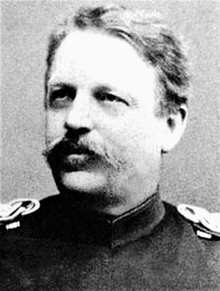Joseph Schröter
Joseph Schröter (14 March 1837 – 12 December 1894)[1] was a noted German mycologist, doctor and scientist.[2] During his lifetime, he wrote several books and texts, and discovered and described many species of flora and fungi. He also spent a considerable amount of time (around fifteen years, from 1871 to 1886) serving as a military doctor, particularly in the Franco-Prussian War, in places such as Spandau, Rastatt and Breslau, and rising to the rank of colonel.

Life
Not much is known about Joseph Schröter's childhood and youth, except that he probably spent those years in or close to Breslau, for that is where he was schooled. Similarly, not much is known about his relatives and family.
In 1855 Schröter chose to study medicine in Breslau, Lower Silesia (Wrocław, Poland since 1945)[3] , but in 1856, he transferred to the Friedrich-Wilhelm Academy in Berlin, Prussia (Germany did not unite into a single nation state until 1871)[4].[2] In 1859 he earned his Doctor of Medicine degree. In the same year, he enlisted in the Prussian army, serving as a doctor in the Franco-Prussian war.[2] He occupied this post to the end of the war, in 1871, before being stationed at Spandau, and later Rastatt.[2] For his efforts as a doctor, as well as the various other contributions he made to the military (particularly during the Franco-Prussian War), Schröter was promoted to the rank of colonel in 1880. He was then stationed at Breslau, where he had been schooled. His career at the University of Breslau began six years later, in 1886, when he was appointed as a lecturer.[2] He stayed at the university teaching for several years, and became a professor in 1890. He died in 1894, after returning from a scientific expedition to Turkey.[2]
Genera described by Schröter
During his lifetime and studies, Schröter described many genera, including:
- Aleurodiscus
- Ceratiomyxa
- Clavulina
- Daedaleopsis
- Dicranophora
- Hygrophoropsis
- Plasmopara
- Sclerospora
- Sorosphaera
- Synchephalastrum
See also
Footnotes
- "Index Fungorum". Retrieved 13 May 2007.
- "www.ilmyco.gen.chicago.il.us". Archived from the original on 30 September 2007. Retrieved 13 May 2007.
- Rhodes, Duncan. "Wroclaw History". local-life.com. Retrieved 20 August 2019.
- "Germany". Encyclopaedia Brittanica. Retrieved 20 August 2019.
- IPNI. J.Schröt.
References
- "Joseph Schroeter" Encyclopædia Britannica
- Heinrich Dörfelt & Heike Heklau (1998). Die Geschichte der Mykologie.